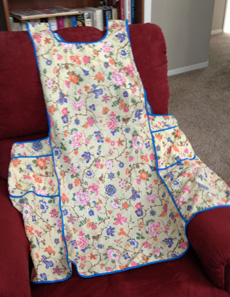My School Wardrobe
With school opening in about three weeks, the newspapers are full of ads of school clothing. In the mid-20th century, school kids had far fewer clothes, but we country kids started planning our wardrobes in the spring. We had to. That’s when we began collecting the colorful cotton feedsacks that we would turn into blouses, skirts, dresses, and shirts.

A feedsack apron
The process began with the arrival of cartoon-cute baby chickens. The chicks lived in a sweltering brooder house, and you had to check the heat, water, and feed frequently.
When you bought the feed, you picked out the prettiest sacks and continued to collect them as the chicks grew into fryers and layers. A dress with a full skirt could take most of three sacks. Often feed buyers liked the same prints, so getting the ones you wanted could be difficult.
Every summer from nine to fourteen, I endured a 4-H sewing project using the feedsacks and, later, the new synthetic fabrics. Once we had the material for the clothes, we chose patterns. These came on a flimsy paper easy to tear as you pinned the coded pieces to the cloth to cut out. Battle strategy is no more complicated than figuring out how to place the patterns on cloth so pieces will match and you waste no cloth.
Once you’d cut the pieces out, you pinned them together and then fit them. That usually required me to stand on a kitchen chair in my underwear and rotate as my mother moved the pins to get a proper fit. She always allowed a bit for growth. I basted some seams to rid of the pins before going to the sewing machine.
In some ways sewing resembles writing. You redo it until you get it right. But sewing machines take hand-and-foot coordination and have no delete button. The seams had to be perfect. That meant I ripped out almost every one at least once. The most frustrating parts were sleeves and zippers.
The final step was ironing out the many wrinkles. Ironing on a hot, humid day gives you a preview of hell. Today I buy nothing that requires ironing.
–Carolyn Mulford
